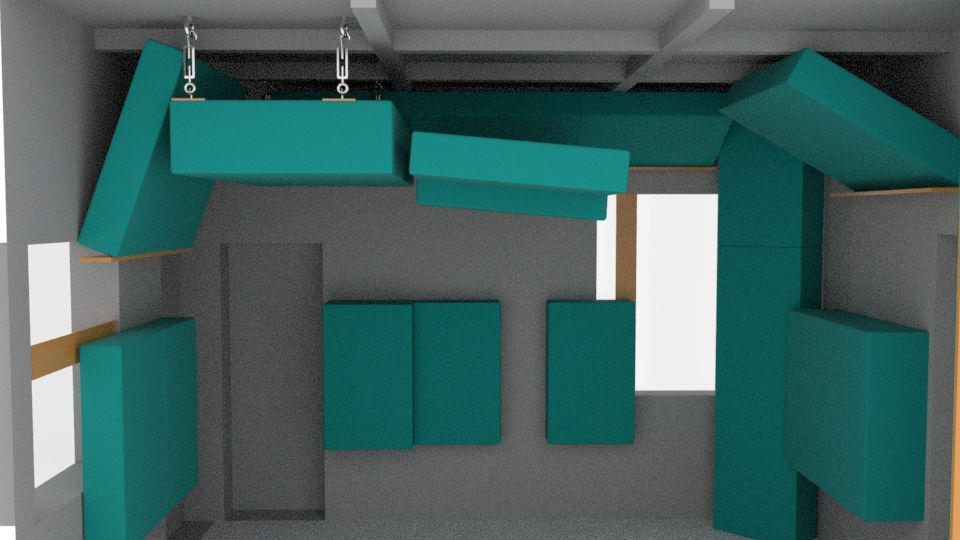Many people ask this a lot. Is cloud absolutely necessary? Is there a workaround? Do I have to live with a fear of so much weight suspended above my head? Short Answer: YES.
WHY?
1) Ceilings as Acoustic Surfaces
Ceilings, often overshadowed by their wall counterparts, wield substantial influence over acoustic performance. Ignoring ceiling acoustics can lead to undesirable sound reflections and standing waves, ultimately affecting the precision of auditory experiences.
A balanced acoustic environment demands equitable treatment of both walls and ceilings. By incorporating measures for sound absorption and diffusion, you create a cohesive acoustic landscape, refining sonic fidelity.
The ceiling just is another surface of your room. No surface is less important. Not even the floor. There is an excuse all of us acousticians compensate with - "the floor effect" and I am no exception. All we say in favor of the mighty studios we build, the floor burns us out. There's simply no way around it.... yet (I'd say, lmao). We can't fix it. Can't put absorption ON the floor. But happily, there's nothing like the "ceiling effect". We can and we do build some heavily absorbing and occasionally diffusing ceilings. So - why not?
2) Depth of Absorption & Frequency Response
The efficacy of absorption hinges on depth, particularly in handling low-frequency content. Shallow absorbers are inadequate in managing low frequencies. Deeper absorbers correlate with the capacity to attenuate lower frequency ranges effectively. GrayVee Acoustics exemplifies this correlation through its absorbers. The VELO S6, with a depth of 7 inches, adeptly manages frequencies as low as 150Hz +/- 20Hz. Taking it a step further, the VELO S12, boasting 13 inches of depth, extends this control to frequencies as low as 80Hz +/- 10Hz. This interplay between absorption depth and frequency response establishes controlled acoustics for lower frequencies, optimizing sound management.
It is very simple mathematics, but if you're a nerd who likes to dig deep, we have a dedicated article specially written for you on the topic of the depth/thickness of absorbers: Broadband Sound Absorber: Understanding the Depths

Drawing from our extensive experience in designing world-class facilities, we recommend that the ceiling treatments occupy approximately 2 to 3 feet of the total room height whenever available, and possibly more (My clients call me a greedy man for their real estate XD).

Large-sized Production Suite - Complex ceiling with an average depth of about 3.5 ft incorporating a few of the many membrane traps and Diffusers. Designed @GrayVee Acoustics (simplified view).

Medium-sized freestanding Listening room - Low vaulted ceilings, with an extensively heavy cloud system focussed above the listening position reaching 3 ft in depth in the absolute front and 10 inches in the rear. Designed @GrayVee Acoustics (simplified view).
In many home studio or small-scale projects, we are presented with spatial and financial constraints. In many such cases, we have gone with horribly thin absorption on walls, which we have been notoriously found to be against all the time, but however, we have never underpowered any ceilings. I know, we say it's about the entire system, and yes that's where I am headed. Luckily, I often have tall enough ceilings to work with if not very tall (9-10.5 ft; good), and we always have the option to have mobile absorbers to take care of the major reflections off the room boundaries, if not all. Hence letting the walls be underpowered is a choice yet a tough one, that we make, but ceilings are never an option.

Tiny Drum room - Ceiling treatments take up 1-2ft space in a sloping roofline with custom QuasiiProjection diffusers. Designed @GrayVee Acoustics. (simplified view)
Cloud Systems: Elevating Small-Scale Solutions
Now, in such small-scale cases, the economic solution turns out to be cloud systems.
This innovative approach serves as a pragmatic solution for smaller studios. These cloud systems, effectively suspended from the ceiling, offer a well-balanced amalgamation of velocity absorbers. Optionally, the integration of diffusers and pressure traps can be explored based on meticulous calculations.
We always recommend using heavy porous absorption on the Primary order reflection points on the ceiling, such as GrayVee Acoustics VELO as mentioned before, S6; 7" deep if not 13" (S12).

Small Home Studio - 2 adjacent cloud suspensions and Perimeter coverage with angled absorbers using GrayVELO S6, and S13. GrayDIA Psuedo-Traps are used on the walls and corners in custom-tailored configs. (Exact config as the build) Once the ceiling is well damped, an addition of controlled diffusers with optimum distance from listening positions can be carefully suspended directly on top of the listening position. Many a time, we have found this approach to help the engineers psychoacoustically. It creates an illusion of a more open soundscape, not pressurizing your mind like a deadened jammed contemporary studio environment does.
All these carefully designed pieces suspended from the ceiling count under cloud systems for a semi-professional space. Thus, a lot more goes into field testing and QC of the smallest item in such products, not only for acoustic performance but for the safety of the engineer sitting beneath these ultra-heavy systems!
In conclusion, recognizing the ceiling's role in shaping home studio acoustics is pivotal. As we always say - a well-designed studio is designed as one whole system where every part of it is working with the other to create a coherent environment for the engineer. Embracing well-designed cloud absorbers, coupled with comprehension of absorption depth and frequency response, cultivates an optimal acoustic environment. GrayVee Acoustics stands committed to bridging the gap between theoretical knowledge and practical implementation. For expert insights and personalized guidance, stay connected with our blog or directly reach out to us via the bubble floating on your screen somewhere in a corner ;). Unleash your home studio's sonic potential and embark on a journey of elevating auditory experiences.


Comments